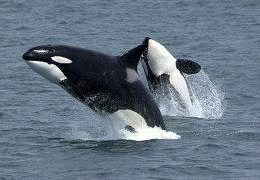Studies have found that only humans, killer
whales and pilot whales have evolved menopause. Why have only these three
species evolved this trait?
The evolutionary explanation for menopause has
suggested a "grandmother" hypothesis which proposes that reproductive
survival is improved by kin selection as well as the continuance of genes -
including genes that are contributed to longevity (Johnstone & Cant 2010;
Powledge 2008).
As discussed in the previous blogs it is known
that female humans evolved menopause due to intense reproductive investment
early in life, or to ‘prevent’ reproduction late in life as there are such
large costs following with only small benefits (Peccei 2001).
Killer Whales (Orca; Orcinus orca) have
family groups of up to 40 individuals, with mothers giving birth every three to
ten years after a 17-month pregnancy. These magnificent creatures can weigh up
to 6 tons and life for an average of 50 to 80 years (National Geographic
Society 2015).
Figure 1. Killer Whales. K.Spear (2010)
Short-finned Pilot Whales (Globicephala macrorhynchus)
are found in groups of roughly 15-20 individuals, however some pods can be as
large as 50 individuals. These beautiful creatures can live up to roughly 45
years and can weigh up to 3.5 ton (Anon 2015).
Figure 2. Short-finned pilot whale. J.D.Watt
(2015)
These two species of whales are the only other
two species known to have evolved menopause alongside humans. Lauren Brenton of
the University of Exter's Centre for Research in Animal Behaviors found that
post-reproductive females improved the survival of their kin through ecological
knowledge transfer (Brent et al. 2015).
This helps to explain why they continue to live long after reproduction
has been ceased. It has been found that these post-reproductive females lead
groups when moving together in foraging grounds and in difficult years when
there is a low food source, the leadership of these menopausal females is
prominent (Brent et al. 2015).
Undoubtedly, selection for a post-reproductive
life span in humans, killer whales and pilot whales most likely evolved as a
result of needed prolonged offspring care, prevention of large reproduction
costs late in life, continuance of genes and knowledge transfer.
References:
Anonymous. (2015). Short Finned Pilot Whale
(Globicephala macrorhynchus). http://us.whales.org/species-guide/short-finned-pilot-whale;
Retrieved 04/04/2014.
Brent, L., Franks, D., Foster, E., Balcomb, K.,
Cant, M. & Croft. (2015). Current Biology:
Ecological knowledge, leadership and the evolution of menopause in
killer whales. http://www.exeter.ac.uk/news/featurednews/title_438490_en.html;
Retrieved 04/04/2015.
Johnstone, R.A., & Cant, M.A. (2010). The
evolution of menopause in cetaceans and humans: the role of demography,
277(1701):3765-3771. Doi: 10.1098/rspb.2010.0988.
National Geographic Society. (2015). Killer Whale
(Orca). http://animals.nationalgeographic.com.au/animals/mammals/killer-whale/;
Retrieved 04/04/2015.
Peccei, J.S. (2001). Menopause: Adaptation or
Epiphenomenon. Evolutionary Anthropology, 10:43-57.
Powledge, T.M. (2008). The Origin of Menopause:
Why Do Women Outlive Fertility? Scientific American, a division of Nature
America, Inc. http://www.scientificamerican.com/article/the-origin-of-menopause/;
Retrieved 04/04/2015.
Watt, J.D. (2015). Short-finned Pilot Whales. http://www.arkive.org/short-finned-pilot-whale/globicephala-macrorhynchus/;
Retrieved 04/04/2015


I come back to this question – why don’t elephants show menopause then? They demonstrate prolonged offspring care, they live in large family groups, live for long periods and have matriarchs that transmit information about resources. Why are they so different from humans, killer whales and pilot whales?
ReplyDelete